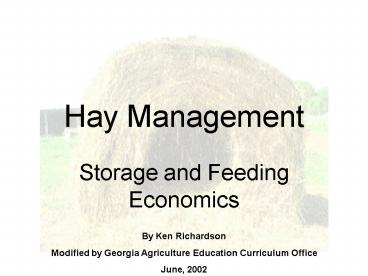Hay Management PowerPoint PPT Presentation
1 / 16
Title: Hay Management
1
Hay Management
- Storage and Feeding Economics
By Ken Richardson Modified by Georgia Agriculture
Education Curriculum Office June, 2002
2
Hay Storage Economics
- Requirements for your herd
- Methods of storage
- Costs of different methods
3
Hay Requirements for a Mature Beef Cow
Total days Days Dry Days Lactating Tons Hay
120 90 30 1.05 120
60 60 1.20 150 90 60 1.43
(DD x 15) (DL x 25) Tons Hay Based on
15 lbs for Days Dry 25 lbs for Days Lactating
4
Hay Requirements for 30 Cow Herd
- Determine average calving date within hay feeding
period. - (Feeding hay from December 1 through March 31
(120 d) - Average calving date is January 29
- Average DD is 60
- Average DL is 60
- (DD x 15) (DL x 25) Tons Hay
- (60 x 15) (60 x 25)
- 900 1500 2400 lbs per cow
- 30 cows x 2400 72,000 lbs 36 Tons Hay
- Does not allow for any waste
5
Storage Methods by Rank
1 Barn Storage 2 Drained Surface with Plastic
Cover 3 Plastic Sleeve 4 Net Wrap 5 Drained
Surface 6 Plastic Cover over Bales 7 Pyramid
Stack with Plastic Cover 8 Bales Placed on
Ground without Cover
6
(No Transcript)
7
Breakeven barn cost for various levels of storage
loss and varying hay value at harvest. (Inputs
other than storage loss and hay value are not
included.) Note This analysis includes the
following assumptions in-barn stacking height of
3 bales, 10-year barn life, and barn construction
cost of 7.50/sq. ft.
8
A Thief on the Farm
- Cost of putting up a ton of Bermuda Grass
Hay 60.38 - A 30 loss to stored bales 18.00
9
Dry matter loss vs average spoilage depth in
round bales of various diameters(volumetric
formula).
10
Equipment or Hay Shelters
- 40 x 100 x 14 (4000 sq ft)
- 6,869 tax (1.72 sq ft)
- 50 x 100 x 14 (5000 sq ft
- 9,018 tax (1.80 sq ft)
- 60 x 100 x 14 (6000 sq ft)
- 10,560 tax (1.76 sq ft)
- 70 x 100 x 14 (7000 sq ft)
- 12,102 tax (1.73 sq ft)
- Tyson Inc. FOB Doerun
11
Costs of Net Wrap
Compared to a string wrap baler 1.00 more per
bale 3000 more for the baler
12
Outside Hay Storage Recommendations
- Store away from trees
- Flat ends butted tightly together
- Store on slope North/South
- Tight bales resists water penetration
- Storage area located on well-drained site
- Hay/soil contact avoided (gravel, pallets, old
tires) - Rounded sides 3 feet apart between rows
- Reduce fire risk, store in several locations
- Harrow around storage areas
13
Key Concepts Regarding Hay Feeding
- Match hay quality to animal needs
- Feed animals on well-drained site
- Feed outside stored hay first
- Feed in hay racks or other barriers
- Feed on wagons with hay racks
- Minimize the amount of hay at one time
- Force clean up by animals with low nutrient
requirements (before feeding more hay)
14
Great differences can occur in the amount of hay
wasted during feeding, depending on management!
15
Costs of Getting Started
Baler 20,000 Tractor (70 hp) 19,000 Mower
7,000 Rake 2,600 Tedder 3,500 Front
Loader 4,500 56,600 Does not include
interest
16
Final Thoughts
With a cow herd of 30 cows or less, most farmers
are better off to buy hay or have custom baling
done on their farm.
The other option is to bale their own hay and
contract or custom bale for their neighbors.

